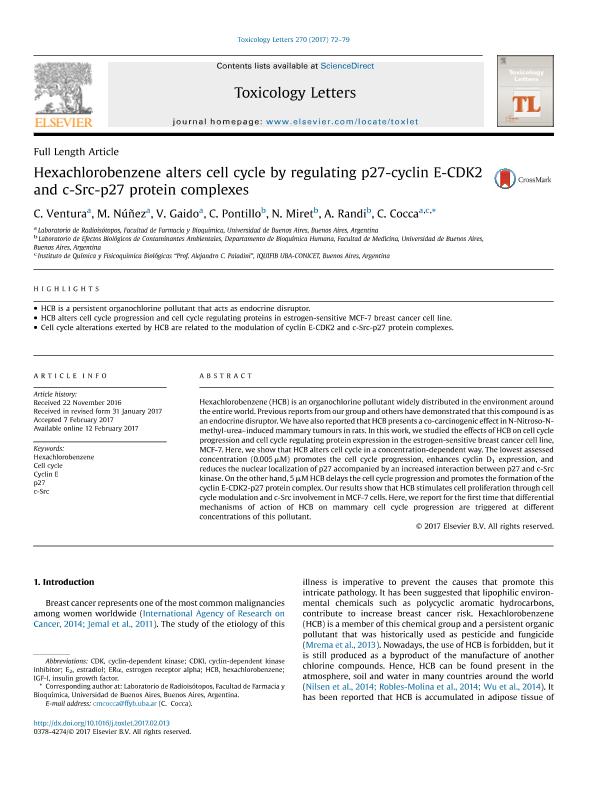Mostrar el registro sencillo del ítem
dc.contributor.author
Ventura, Clara

dc.contributor.author
Núñez, M.
dc.contributor.author
Gaido, Vanesa Elisabeth

dc.contributor.author
Pontillo, Carolina Andrea

dc.contributor.author
Miret, Noelia Victoria

dc.contributor.author
Randi, Andrea Silvana

dc.contributor.author
Cocca, Claudia Marcela

dc.date.available
2018-06-05T14:08:59Z
dc.date.issued
2017-03
dc.identifier.citation
Ventura, Clara; Núñez, M.; Gaido, Vanesa Elisabeth; Pontillo, Carolina Andrea; Miret, Noelia Victoria; et al.; Hexachlorobenzene alters cell cycle by regulating p27-cyclin E-CDK2 and c-Src-p27 protein complexes; Elsevier Ireland; Toxicology Letters; 270; 3-2017; 72-79
dc.identifier.issn
0378-4274
dc.identifier.uri
http://hdl.handle.net/11336/47288
dc.description.abstract
Hexachlorobenzene (HCB) is an organochlorine pollutant widely distributed in the environment around the entire world. Previous reports from our group and others have demonstrated that this compound is as an endocrine disruptor. We have also reported that HCB presents a co-carcinogenic effect in N-Nitroso-N-methyl-urea–induced mammary tumours in rats. In this work, we studied the effects of HCB on cell cycle progression and cell cycle regulating protein expression in the estrogen-sensitive breast cancer cell line, MCF-7. Here, we show that HCB alters cell cycle in a concentration-dependent way. The lowest assessed concentration (0.005 μM) promotes the cell cycle progression, enhances cyclin D1 expression, and reduces the nuclear localization of p27 accompanied by an increased interaction between p27 and c-Src kinase. On the other hand, 5 μM HCB delays the cell cycle progression and promotes the formation of the cyclin E-CDK2-p27 protein complex. Our results show that HCB stimulates cell proliferation through cell cycle modulation and c-Src involvement in MCF-7 cells. Here, we report for the first time that differential mechanisms of action of HCB on mammary cell cycle progression are triggered at different concentrations of this pollutant.
dc.format
application/pdf
dc.language.iso
eng
dc.publisher
Elsevier Ireland

dc.rights
info:eu-repo/semantics/openAccess
dc.rights.uri
https://creativecommons.org/licenses/by-nc-sa/2.5/ar/
dc.subject
C-Src
dc.subject
Cell Cycle
dc.subject
Cyclin E
dc.subject
Hexachlorobenzene
dc.subject
P27
dc.subject.classification
Otras Ciencias de la Salud

dc.subject.classification
Ciencias de la Salud

dc.subject.classification
CIENCIAS MÉDICAS Y DE LA SALUD

dc.title
Hexachlorobenzene alters cell cycle by regulating p27-cyclin E-CDK2 and c-Src-p27 protein complexes
dc.type
info:eu-repo/semantics/article
dc.type
info:ar-repo/semantics/artículo
dc.type
info:eu-repo/semantics/publishedVersion
dc.date.updated
2018-06-04T17:09:02Z
dc.journal.volume
270
dc.journal.pagination
72-79
dc.journal.pais
Países Bajos

dc.journal.ciudad
Amsterdam
dc.description.fil
Fil: Ventura, Clara. Consejo Nacional de Investigaciones Científicas y Técnicas; Argentina. Universidad de Buenos Aires. Facultad de Ingeniería. Departamento de Física. Laboratorio de Radioisótopos; Argentina
dc.description.fil
Fil: Núñez, M.. Universidad de Buenos Aires. Facultad de Ingeniería. Departamento de Física. Laboratorio de Radioisótopos; Argentina
dc.description.fil
Fil: Gaido, Vanesa Elisabeth. Universidad de Buenos Aires. Facultad de Ingeniería. Departamento de Física. Laboratorio de Radioisótopos; Argentina
dc.description.fil
Fil: Pontillo, Carolina Andrea. Universidad de Buenos Aires. Facultad de Medicina. Departamento de Bioquímica Humana; Argentina
dc.description.fil
Fil: Miret, Noelia Victoria. Universidad de Buenos Aires. Facultad de Medicina. Departamento de Bioquímica Humana; Argentina
dc.description.fil
Fil: Randi, Andrea Silvana. Consejo Nacional de Investigaciones Científicas y Técnicas; Argentina. Universidad de Buenos Aires. Facultad de Medicina. Departamento de Bioquímica Humana; Argentina
dc.description.fil
Fil: Cocca, Claudia Marcela. Consejo Nacional de Investigaciones Científicas y Técnicas. Oficina de Coordinación Administrativa Houssay. Instituto de Química y Físico-Química Biológicas "Prof. Alejandro C. Paladini". Universidad de Buenos Aires. Facultad de Farmacia y Bioquímica. Instituto de Química y Físico-Química Biológicas; Argentina. Universidad de Buenos Aires. Facultad de Ingeniería. Departamento de Física. Laboratorio de Radioisótopos; Argentina
dc.journal.title
Toxicology Letters

dc.relation.alternativeid
info:eu-repo/semantics/altIdentifier/doi/https://dx.doi.org/10.1016/j.toxlet.2017.02.013
dc.relation.alternativeid
info:eu-repo/semantics/altIdentifier/url/https://www.sciencedirect.com/science/article/pii/S0378427417300619
Archivos asociados
